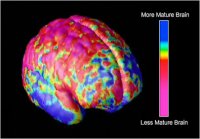
Schizophrenia
An Introduction to Schizophrenia
Contrary to the common misconception, schizophrenia does not mean "split personality" or "multiple personalities." And, although people with schizophrenia are often portrayed as violent on television and in movies, that is seldom the case. Schizophrenia is one of the most disabling and puzzling mental disorders in existence. Just as the term "cancer" refers to numerous related illnesses, many researchers now consider schizophrenia to be a group of mental disorders rather than a single illness.
Generally, schizophrenia begins in late adolescence or early adulthood. Research indicates a genetic link to the development of schizophrenia.
A child who has one parent with schizophrenia, for example, has about a 10 percent chance of developing the illness, compared to a 1 percent chance if neither parent has schizophrenia.
Current research suggests that schizophrenia is related to abnormalities in both the brain's structure and biochemical activities. Researchers also tend to agree that environmental influences may be involved in the onset of schizophrenia.
Symptoms
Schizophrenia symptoms fall into three broad categories: positive, negative, and cognitive.
Psychotic, or "positive," symptoms include:
- Delusions (bizarre thoughts that have no basis in reality)
- Hallucinations (hearing voices, seeing nonexistent things, and experiencing sensations, such as burning, that have no source)
- Disordered thinking (apparent from a person's fragmented, disconnected and sometimes nonsensical speech).
"Negative" symptoms include things like:
- Social withdrawal
- Extreme apathy
- Diminished motivation
- Blunted emotional expression.
These symptoms are harder to recognize as part of the disorder and can be mistaken for laziness or depression.
Cognitive symptoms (or cognitive deficits) are problems with attention, certain types of memory, and the executive functions that allow us to plan and organize. Cognitive deficits can also be difficult to recognize as part of schizophrenia but are the most disabling in terms of leading a normal life.
Schizophrenia is diagnosed in someone with active schizophrenic symptoms (such as a psychotic episode) for at least two weeks, with other symptoms lasting six months.
People who have schizophrenia often require medication to control the most troubling symptoms. Antipsychotic medications help bring biochemical imbalances closer to normal. The newer drugs may also be effective for symptoms such as social withdrawal, extreme apathy, and blunted emotional expression. Other similar drugs are currently being developed.
Living With Schizophrenia
After the symptoms are controlled, psychotherapy and self-help groups can help people who have schizophrenia:
- Develop social skills
- Cope with stress
- Identify early warning signs of relapse
- Prolong periods of remission.
Support groups and family therapy can give loved ones a better understanding of the illness and help them provide the compassion and support that play an important role in recovery. The good news is that many of those who have schizophrenia can work, live in the community or with their families, and enjoy friends if they receive continuous, appropriate treatment. According to The National Alliance on Mental Illness, schizophrenia treatment is successful in 60 percent of patients.
The outlook for people with schizophrenia has improved over the last 30 years or so. Although a cure still does not exist, effective treatments have been developed and many people with schizophrenia improve enough to lead independent, satisfying lives.
This is a very exciting time for schizophrenia research. The explosion of knowledge in genetics, neuroscience, and behavioral research are all being used to understand the causes of the disorder, how to prevent it, and how to develop better treatments to allow those with schizophrenia to achieve their full potential.






 Ghassan A. Chehab
Ghassan A. Chehab
 Solange El-jbeily
Solange El-jbeily
